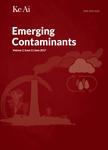Occurrence of micropollutants in the wastewater streams of cruise ships
作者机构:Hamburg University of Technology21071HamburgGermany Leibniz University HannoverInstitute for Sanitary Engineering and Waste Management30167HannoverGermany Hamburg University of TechnologyCentral Laboratory21071HamburgGermany
出 版 物:《Emerging Contaminants》 (新兴污染物(英文))
年 卷 期:2016年第2卷第4期
页 面:178-184页
学科分类:083002[工学-环境工程] 0830[工学-环境科学与工程(可授工学、理学、农学学位)] 08[工学]
主 题:Cruise ships Organic micropollutants PPCPs Wastewater MBR Permeate
摘 要:Nowadays the protection of the marine environment raises increasing academic and public *** issue of organic micropollutants is of equally high importance for the marine *** vessels are considered to significant sources of micropollutants especially if the ship carries many passengers,which is often true for cruise ships which frequent attractive and sensitive sea *** emission pathways for micropollutants include wastewater discharges and sewage sludge *** findings of the German research and development project NAUTEK contribute to bridging the knowledge gap about micropollutant emissions from cruise *** expected,micropollutants were detected in both the blackwater and greywater on board,emitted from either the passengers or certain ship *** total,16 out of 21 target substances were *** concentrations of pharmaceuticals could be found mainly in blackwater(peak *** 3.9 mg/L,Ibuprofen 29 mg/L,Diclofenac 0.04 mg/L),while greywater is mainly characterized by substances such as ointment residues,UV-filters and flame retardants(peak *** 0.65 mg/L,Bisphenol A 8 mg/L,Tris(1-chloro-2-propyl)phosphate 136 mg/L).Further analyses suggest a gradual removal of the micropollutants by the onboard MBR plant(MBR effluent peak *** 0.47 mg/L,Ibuprofen 6.8 mg/L,Diclofenac 0.3 mg/L).Findings of this research provide a critical stepstone for shaping technical solutions for onboard micropollutants removal and water resource recycling.



